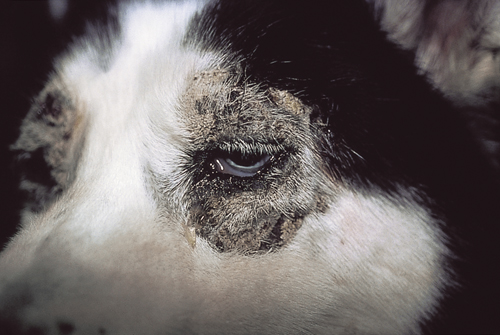Difference between revisions of "Small Animal Dermatology Q&A 22"
Ggaitskell (talk | contribs) (Created page with "{{Template:Manson Moriello}} centre|500px<br> <br /> '''A 3-year-old female Siberian husky dog is presented for the complaint of ...") |
|||
| (3 intermediate revisions by 2 users not shown) | |||
| Line 17: | Line 17: | ||
This is called syndrome I of zinc-responsive skin diseases. <br><br> | This is called syndrome I of zinc-responsive skin diseases. <br><br> | ||
Syndrome II occurs in rapidly growing dogs that are fed zinc deficient diets high in phytates or minerals (e.g. calcium), or diets oversupplemented with minerals and vitamins that interfere with zinc absorption. | Syndrome II occurs in rapidly growing dogs that are fed zinc deficient diets high in phytates or minerals (e.g. calcium), or diets oversupplemented with minerals and vitamins that interfere with zinc absorption. | ||
| − | |l1= | + | |l1=Zinc Deficiency |
|q2=How should the dog be treated, and how soon would resolution of clinical signs be expected? | |q2=How should the dog be treated, and how soon would resolution of clinical signs be expected? | ||
|a2= | |a2= | ||
| Line 27: | Line 27: | ||
*Improvement in clinical signs is usually evident within a few weeks. | *Improvement in clinical signs is usually evident within a few weeks. | ||
*After the diagnosis, the lesions should be hydrated and the crusts soaked off. | *After the diagnosis, the lesions should be hydrated and the crusts soaked off. | ||
| − | |l2= | + | |l2=Zinc Deficiency#Treatment |
|q3=What endocrine disease may play a role in the pathogenesis of this disease? | |q3=What endocrine disease may play a role in the pathogenesis of this disease? | ||
|a3=Thyroid hormones are important in the absorption and utilization of zinc. <br><br> | |a3=Thyroid hormones are important in the absorption and utilization of zinc. <br><br> | ||
Dogs that develop spontaneously occurring hypothyroidism may develop clinical and histological signs of zinc-responsive skin disease. <br> | Dogs that develop spontaneously occurring hypothyroidism may develop clinical and histological signs of zinc-responsive skin disease. <br> | ||
These dogs may fail to respond to zinc supplementation if their hypothyroidism is not diagnosed and treated. | These dogs may fail to respond to zinc supplementation if their hypothyroidism is not diagnosed and treated. | ||
| − | |l3= | + | |l3=Hypothyroidism |
</FlashCard> | </FlashCard> | ||
{{#tag:imagemap|Image:Next Question.png{{!}}center{{!}}200px | {{#tag:imagemap|Image:Next Question.png{{!}}center{{!}}200px | ||
| − | rect 0 0 860 850 [[Small Animal Dermatology Q&A | + | rect 0 0 860 850 [[Small Animal Dermatology Q&A 01|Next question]] |
desc none}} | desc none}} | ||
[[Category:Small Animal Dermatology Q&A]] | [[Category:Small Animal Dermatology Q&A]] | ||
Latest revision as of 13:45, 1 September 2011
| This question was provided by Manson Publishing as part of the OVAL Project. See more small animal dermatological questions |
A 3-year-old female Siberian husky dog is presented for the complaint of ‘crusties’. The owner reports the dog has pruritic crusty lesions on the face and ears. On dermatological examination, the lesions around the eyes are symmetrical, and similar lesions are present on the ear margins, chin, ears, footpads, and pressure points. The skin is thickened and hyperkeratotic crusting is present. The dog is healthy otherwise. The dog is fed a complete and balanced diet. Two littermates, owned by other people, have similar lesions.
| Question | Answer | Article | |
| What is the most likely diagnosis and how should this be confirmed? | Zinc-responsive skin disease. The signalment, clinical signs, and affected littermates are compatible with zinc deficiency. The diagnosis could be confirmed by skin biopsy.
This is called syndrome I of zinc-responsive skin diseases. |
Link to Article | |
| How should the dog be treated, and how soon would resolution of clinical signs be expected? | This dog needs 1 mg/kg of elemental zinc each day.
|
Link to Article | |
| What endocrine disease may play a role in the pathogenesis of this disease? | Thyroid hormones are important in the absorption and utilization of zinc. Dogs that develop spontaneously occurring hypothyroidism may develop clinical and histological signs of zinc-responsive skin disease. |
Link to Article | |
